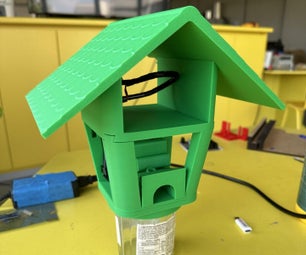Introduction: DIY Lab Bench Power Supply
Everyone has those older or newer ATX power supplies laying around. Now you have three options. You can throw them in your garbage, salvage some good parts or build a DIY lab bench power supply. The parts are dirt cheap and this supply can deliver more amps than some modern variable ones. Let's build it.
Step 1: Watch the Video!
The video gives you all explanation you need to build this project. But I will tell you the most important steps again, this way you can not screw this up.
Step 2: Order Your Parts!
Here is the list of parts I used in this project (affiliate links):
Ebay:
5x Binding posts (red):http://rover.ebay.com/rover/1/711-53200-19255-0/1?...
1x Binding post (black):http://rover.ebay.com/rover/1/711-53200-19255-0/1?...
1x Toggle Switch:http://rover.ebay.com/rover/1/711-53200-19255-0/1?...
1x 3mm Green LED:http://rover.ebay.com/rover/1/711-53200-19255-0/1?...
1x 3mm Red LED:http://rover.ebay.com/rover/1/711-53200-19255-0/1?...
2x 220Ω Resistor:http://rover.ebay.com/rover/1/711-53200-19255-0/1?...
Shrinking tube:http://rover.ebay.com/rover/1/711-53200-19255-0/1?...
Amazon.de:
5x Binding posts (red): http://amzn.to/1xldoN1
1x Binding post (black): http://amzn.to/1nwk0r1
1x Toggle Switch: http://amzn.to/1xleBDV
1x 3mm Green LED: http://amzn.to/1xleBDV
1x 3mm Red LED: http://amzn.to/1xleBDV
2x 220Ω Resistor: http://amzn.to/1xleBDV
Shrinking tube: http://amzn.to/1xleBDV
Aliexpress:
5x Binding posts (red): https://s.click.aliexpress.com/e/_dZftVoF
1x Binding post (black): https://s.click.aliexpress.com/e/_dZftVoF
1x Toggle Switch: https://s.click.aliexpress.com/e/_d9dxPD5
1x 3mm Green LED: https://s.click.aliexpress.com/e/_dT0Osqb
1x 3mm Red LED: https://s.click.aliexpress.com/e/_dT0Osqb
2x 220Ω Resistor: https://s.click.aliexpress.com/e/_dTPpXjt
Shrinking tube: https://s.click.aliexpress.com/e/_dXH34Rz
Step 3: Get the Right Resistor!
You may already noticed that we have to put a dummy load on the supply to keep it stable even when we only draw small amounts of current.
I recommend the dummy load should draw at least 0.5A.
Here is the calculation if you have most of your power on 5V/3,3V rail:
R=U/I=5V/0,5A=10Ω
P=U*I=5V*0,5A=2,5W
Buy it here:http://amzn.to/1xlhJzI
http://www.ebay.com/itm/10W-10-R-Ohm-Ceramic-Cemen...
Here is the calculation if you have most of your power on 12V rail:
R=U/I=12V/0,5A=24Ω
P=U*I=12V*0,5A=6W
Buy it here:http://www.ebay.com/itm/2x-10W-10-Watt-High-Power-...
Step 4: Make the Correct Connections!
What does each wire mean and where does it connect to? You can find a schematic here which tells you how to connect the parts. Anyway here is my written version of this schematic:
Orange (3,3V) ---> 3,3V red binding post
Red (5V) ---> 5V red binding post
--------------> 10Ω 10W resistor
---------------> 220Ω resistor of 3mm green LED
White (-5V) ---> -5V red binding post
Yellow (12V) ---> 12V red binding post
Blue (-12V) ---> -12V red binding post
Brown (3,3V Sense) ---> 3,3V binding post
Purple (5V Standby) ---> 220Ω resistor of 3mm red led
Green (Power ON) ---> One side of the toggle switch
Black (Ground) ---> GND black binding post
-----------------------> Cathode of 3mm green LED
-----------------------> Cathode of 3mm red LED
-----------------------> 10Ω 10W resistor
-----------------------> other side of the toggle switch
Grey (Power Good) --> not connected
If you have most of your power on the 12V rail then you need to connect a 24Ω resistor to 12V instead of 10Ω to 5V.
Step 5: Success!
Everything works! Now you can build even more awesome electronics projects with the help of this bench power supply!
Feel free to check out my Youtube channel for more awesome projects:
http://www.youtube.com/user/greatscottlab
You can also follow me on Facebook, Twitter and Google+ for news about upcoming projects and behind the scenes information.











